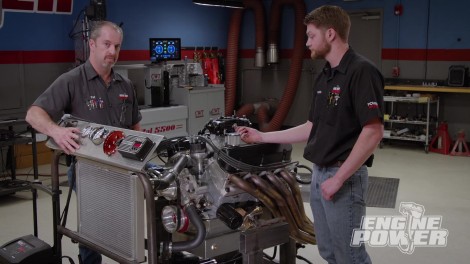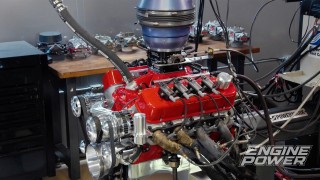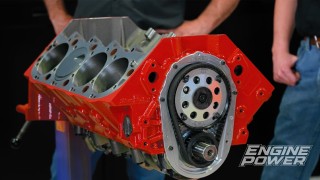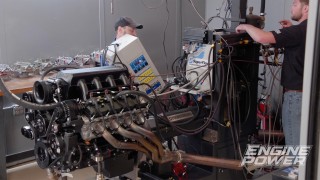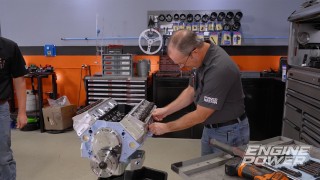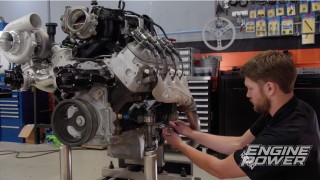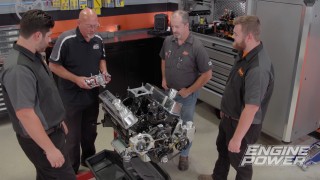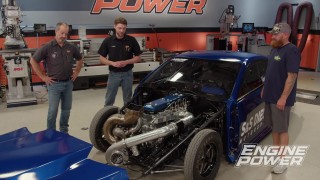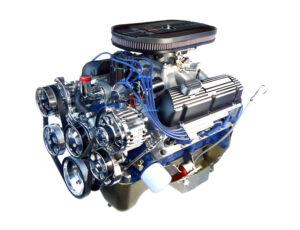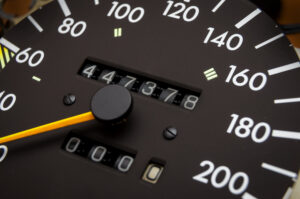Engine Power Featured Projects
Engine Power Builds
Want more content like this?
Join the PowerNation Email NewsletterVideo Transcript
(Pat)>> You're watching Powernation!
(Frankie)>> Once you understand the top five reasons why your engine won't start it becomes much easier to figure out and fix what's going wrong. [ Music ]
(Pat)>> Hey everyone, here on Engine Power you get to watch us build a lot of cool projects no matter the brand. You get to see us pick parts, do some machining and assembly, and get it all together, fired up, and proven in our dyno cell. Usually everything works pretty smoothly, and that's because we have a very methodical way we put things together and test them to make sure everything will go right. But we always get the question, what happens when things don't go smoothly? Well, it happens to everyone no matter what your level of experience. So, we decided to take the time today to show you the top five reasons why your engine won't start.
(Frankie)>> There are a lot of things that go into making an engine start and run successfully, and these five things are the basics that we go back to when we have troubles. The first four are... [ bleep ] ...what every engine needs to run, and the fifth one is one that is hardest to catch and will usually give you the most trouble. So today we're gonna look at them together, and to do that we're gonna be using our 408 Windsor that's on this run stand because this is something you don't need a dyno to go. You can do it in the car or on a run stand at home.
(Pat)>> The first thing we're gonna talk about is air, or lack thereof. I realize this is the most trivial one. How can we not have enough air to run an engine. We're not underwater. So it should run. Well, that is not always the case. Some things can just happen where it has a severe restriction enough where it simply will not run. For instance, if this was on top of this carburetor and I tried to start it it obviously wouldn't run. Not enough air going through to pull fuel out of the bowls. So not enough air to run. Other examples on like new builds. You see us do it all the time. We will tape off the intake plenum so when we are finishing assembling the rest of the engine we don't accidentally drop anything down the intake tract that can get in the cylinders. Sometimes that can get overlooked and you put the rest of the induction on forgetting that was taped up and then try to start it. Once again, no air. Even on fuel injected applications you can have the throttle body capped off for the same reasons. Once again, not enough air, engine will not run. When you go pick up something from the salvage yard for your project sometimes people hose them off and put them right in the vehicles and see if they run. Well, a lot of the times they will block off intentionally the intake tract so nothing gets in it from parts, to animals. So, we've had engines come in here where there are actually rags in the intake ports. We have had birds' nests in the air cleaner. We have had bugs completely close off a carburetor or an intake tract where no air can get through. So, air seems a little bit like it's an easy thing to fix but I assure you it's as important as the rest of them.
(Frankie)>> Even if your engine will start but maybe won't stay running or idling on its own it can be an air issue, and it can be something as simple as the throttle blades are closed too much and they won't allow enough air to enter the engine. On a carbureted application this can be a little bit trickier to find, and on a fuel injected application it's still just as important because the throttle blade has to be set in the correct position for the idle air control motor to restrict and allow enough air to effectively control the idle. This is something that we see a lot where guys try to close the throttle blades too much, get the idle too low in the r-p-m range, and then even if your engine will start and run if that throttle blade is closed too much you can still cause trouble and have all kinds of issues with your transition and load-in. The engine will start doing whacky things, and it can really be as simple as having that throttle blade position in the right spot. Another case where we can see that the engine will start and run but maybe has no power or runs poorly is a restriction in the intake. Not as drastic as what Pat was talking about but a restriction nonetheless. The first one that you probably think of is the air filter element. Whether it's extremely clogged with dirt, debris, or bugs, or maybe something a little bit tricker where someone has oiled a non-oilable air filter element. This can cause a restriction where the engine will run poorly, be down on power, and it can be kinda hard to track down if you don't know what you're looking for. With some of the newer engines we see being swapped into older rides that have direct injection a big problem that we can see with high mileage is carbon being caked to the back of the intake valve. Now the engine will still run and it will drive, but it will be extremely down on power, and this can be hard to find without a borescope or tearing the engine apart. These seem like simple things, but they can give you a lot of headache if you're chasing your tail around trying to figure out a problem, and sometimes you just have to take a step back, think about all the parts in the system, how they work together, and start eliminating variables one by one.
(Pat)>> Up next, you put fuel in the tank but are you sure it's getting to the engine? We'll show you how to make certain.
(Pat)>> Next up on the top five reasons your engine won't start, in no particular order, is fuel. I know this seems very obvious, but it is easily overlooked when you are in a hurry trying to get your project running. So, we are going to go over from where the fuel comes in to where the fuel comes out, and that starts with putting fuel in it.
(Frankie)>> I know it sound simple but if your fuel gauge doesn't work or maybe it reads inaccurately a great way to eliminate the variable is simply put some in it.
(Pat)>> Now the fuel for the application is obvious. If it's a gasoline engine you're not gonna put diesel in it, and if it's a race engine you're not gonna put pump gas in it. We're just trying to get things running. So, we're gonna eliminate the first variable, putting fuel in the system.
(Frankie)>> We're not saying you have to fill the entire tank in case you have to drain it later, but you want to put a substantial amount in to make sure you have enough to cover the pickup and fill the entire system.
(Pat)>> Now that we have confirmed there is fuel in the system and the engine still won't start we have to start going down the line, and seeing what's up, and find the problem. A great way to diagnose any fuel system problem is to have a fuel pressure gauge somewhere in the system. On our carbureted one it is right in our fuel log. On an e-f-i system it is nice to have it in the rail or in a pressure tap where you can actually put a mechanical gauge in to check the pressure. On a mechanical style fuel system it has a fuel pump that's usually bolted to the engine somewhere, and there's an eccentric on the camshaft that runs an arm or a push rod that runs a diaphragm in the pump, and that diaphragm's actuation is what pulls fuel from the tank. Well, if you're not getting fuel to the gauge you know something is wrong in the system, and one of those is pretty easy to find but there's some very common problems. One, the pump could be simply hooked up backwards. If the inlet is on the outlet side and vice versa it will not pump fuel to the carburetor. Another one is the diaphragm in the fuel pump might not even be working. Sometimes on old ones they dry out and just simply don't work anymore, but that will be indicated on the gauge if it's happening. Some aftermarket mechanical pumps can generate more pressure than is needed and need to be regulated down. A typical 41-50 style carb requires between five and seven p-s-i, but if you go over that it can overpower the needle and seat, pouring a bunch of fuel into the manifold, and potentially hydro-locking the engine. If that is the case you would obviously see that on the gauge itself. So even an over pressure or an under pressure situation can be solved with a gauge.
(Frankie)>> An e-f-i system is pretty much the same in terms of trouble shooting, but the system itself has some different components. Virtually every e-f-i system is fed by an electric fuel pump, and some carbureted applications are as well. If you have an electric fuel pump and no pressure on a mechanical gauge the first thing you want to check, is the pump actually running? It seems like a silly concept but if the pump isn't running at all you're not gonna have any pressure. So, the first thing you want to check is make sure your wiring is good, that you have good power and good ground, that they're in the right locations and the pump isn't wired backwards. And if the pump is running and you still have no pressure another thing to check, maybe the pump is in backwards. Most pumps are marked for flow, but if they're not that's something to double check. Otherwise, it's simply gonna pump all the fuel back into the tank. If the pump is running in the right direction and you still have no pressure the next thing you want to check is the filters. On our run stand we have an external fuel filter, and we have it before the pump but sometimes they can be after or it can have a fuel filter before and after the pump. But if either of those are clogged, whether it be from dirt, debris, rust, or foam, if the filter is completely clogged it's not gonna allow pressure to get through the fuel system. So that's something that's really important to check. Sometimes in o-e or later model applications there can be a combination of a fuel filter and regulator. So that makes it a little bit more complicated to check, but something that still needs to be checked nonetheless. Generally, in an e-f-i system we like to see the fuel pressure set at 43 or 58 p-s-i depending on the manufacturer's recommendations, and you want it to be set at that recommendation because if the fuel system has too much pressure you can inject too much fuel into your engine, or if it's too low not enough. Now if the engine has good pressure sitting still but under load the pressure drops you could have a partially restricted filter or a restricted line.
(Pat)>> Last but certainly not least are the conditions of the lines. When you're putting an engine in a vehicle, and usually the last thing that gets checked are the lines themselves. Old lines can have rust in them, be kinked, or clogged in some way. It is always nice to make new lines if possible and minimize the use of rubber, because when you put a rubber line on steel line you run the risk of wadding up a bunch of rubber on there, and it can be okay when it is idling but as soon as it gets under load and the fuel demand goes up the pressure could go down.
(Frankie)>> When making new lines though it's really important that you blow them out completely before you put fuel through them. Any shop debris or metal that could be in them you want to get that out. You don't want that going into your fuel filter, or if it makes it all the way to the fuel delivery device, your carburetor jets or injectors, cause all that's gonna do is wreak havoc. Coming up, a couple of sure fire reasons your engine won't start.
(Frankie)>> We are moving along great, and the next topic we're gonna cover in the list of top five reasons why your engine won't start is spark, and spark is a little bit more complicated than fuel. Fuel systems are relatively simple even though there's a few variations, but ignition systems can vary greatly, and there's a lot more components that go into it. The first thing we need to talk about is how to actually check for spark. The best way to do it is to physically pull a spark plug, have it connected to the system, and have it grounded on the engine. Then you turn the engine over and you visually look for spark. Either you have spark or you don't, and if you don't the first thing we need to check is the battery. Electrical systems are very hard to diagnose unless you know the battery is good and fully charged. So, if we have a fully charged battery then we can start looking at components. For a demonstration we're gonna be using our 408 Windsor that has a distributor ignition system with a c-d-i box and a coil because this is what we commonly deal with in hot rodding. It all starts with the distributor. Underneath the cap and the rotor there is a reluctor wheel that passes by a pickup, in this case a magnetic pickup, and when that reluctor passes in front of the pickup it generates an a-c signal out of these two wires. These are relatively simple. It's what gives the ignition box the r-p-m signal and tells it when to fire the coil, and if that reluctor is passing in front of the pickup it should be generating an a-c signal. Which means to check it you do have to have the engine turning over, but if it's not generating that signal chances are the pickup could be bad. In this application we're not using the pickup in the distributor. We're actually using a crank trigger on the front of the engine, but it's basically the same. It's just a little bit bigger and more accurate. The next piece in the ignition system is the ignition box, and these can seem a little bit daunting or confusing, but they have a very simple task to perform. They take that signal from the distributor and output a signal to the coil to make it fire. So as long as they have 12 volt keyed ignition, they have 12 volt power and ground from the battery, and are getting that a-c signal from the pickup they should be triggering the ground side of the coil. If it's not and the wiring is good chances are the ignition box could be bad if you have no spark. The next piece is the coil itself, and these are even more simple. You can actually test the coil on the primary and secondary windings for resistance to check them if you know the values that you're looking for. If we have no spark a quick and easy test is that if the coil has 12 volt keyed ignition to the positive side and had a triggered ground that is being triggered by the ignition box on the negative side and is not generating a spark chances are the coil is bad. From there the spark energy travels down the coil wire into the rotor, and then is distributed to each terminal on the cap down the spark plug wires and to the spark plugs. Now that we know all of these components are good we have strong spark at the plug.
(Pat)>> And that is great news, but you try to start the engine and it still won't run, and that can involve a few different things. Just because you have the right amount of spark doesn't mean it's happening at the right time or going to the right place, and that involves a lot of stuff to do with the distributor, and the wires, and the plugs, if the distributor is not in the engine correctly, it's not indexed to the proper terminal, the engine won't run correctly. You've seen us put distributors in the correct way a bunch of different times. It has to be right for it to run. Also, the engine has to be wired right on the plug wires. It has to be in the proper firing order. You can also put the proper firing order on the distributor but going the wrong direction. Depending on what brand of engine you have sometimes the distributor turns clockwise or counterclockwise on the rotor side depending on where the actual distributor is in the engine. So that has to be right. Another thing is the spark plug wires themselves. You can make plug wires and sometimes have a problem with the way it's crimped. It is recommended that you check every one of them with an ohm meter to see if the plug wire is good. That is a super simple test that can be performed with an ohm meter, right Frankie?
(Frankie)>> Yeah, it's something that's pretty easy to do. So, we were gonna take a second and show you guys on these MSD wires that we made custom for our 408 Windsor. The first thing we're gonna do is take our d-v-o-m and put it in the ohm setting. Then we're gonna take each of our leads and insert them into the terminals at either end of the wire. Let's see what we get for a reading. This one's about 83. So, we're gonna take that number and we're gonna divide it by the length of the wire in feet. This wire's about 21 inches, or 1.75 feet. 83 divided by 1.75 gives us about 47 ohms per foot, which is perfect. It's right in the recommended range from MSD at 45 to 50 ohms per foot. Now if your wire is way over the manufacturer's recommendations or has no continuity at all that's a bad wire and it's gonna need to be changed.
(Pat)>> The last link in our spark chain is the spark plug itself. These get taken for granted a lot of the times because it's an easy part, but it takes a lot of stuff to make this work right, meaning it can't have any damage. When you have a new plug or a good used plug you want to inspect it before you use it. Obviously you look for cracks in the porcelain. You make sure that the gap is set for your application. Make sure the ground strap is not touching the center electrode. It won't spark if that happens. Another thing that's very, very important. If this plug receives any sort of bump or impact, meaning if you're putting your headers on and you touch the header or bump the header onto your spark plug, or this falls out of your hand and hits the ground, the next place this plug should go is the garbage can. The last thing you will want to use is a potentially damaged spark plug.
(Frankie)>> But we have all new plugs, and we have all new wires that have been checked. So, let's get these on and get this thing going. I think these are yours. [ Music ]4
(Pat)>> Up next, the last two entries on our top five list. You don't want to hear number five.
(Pat)>> So far we've shown you three of the top five reasons why your engine won't start. We now have air, we have fuel, and we have spark. So, the next thing we'll go over is compression. An internal combustion engine needs compression so the air/fuel mix will light easier, and there will be a few reasons why you wouldn't have compression in an engine. For instance, in a junkyard engine situation sometimes the engine's just set for too long, and the valves are stuck, and they're hung open. Turns over, no compression. Also, the engine could have some sort of other mechanical failure that you don't know about. So, it's important to check for compression before you try to get the thing running. In a new build sometimes you have the wrong parts, or they have been adjusted incorrectly. Once again, hanging valves open and having no compression. So, we are gonna show you a couple of sure fire ways to show you that your cylinder has compression and the cylinder is in good condition.
(Frankie)>> There's only a few places the air/fuel mixture can escape out of the cylinder, and there's a few tests we can do to determine if the cylinder has adequate compression, and if it doesn't where it is going. Between a cylinder compression test and a cylinder leak down test we can get a great idea of the health of the cylinder and if we have a problem start tracking it down. We've shown you these tests before, but we wanted to quickly go over it one more time just to be sure. The first we'll do is a cylinder leak down test since a junkyard engine might not have a starter on it for you to crank it over. After removing the spark plug wire and the spark plug, with that cylinder set with its piston at t-d-c on compression stroke we can install the hose and connect it to 100 p-s-i regulated shop air. The gauge will give us the readout and tell us the amount of leakage that is escaping the cylinder. For this engine, a hard abused dyno mule, 12 percent is pretty good, and anything under 20 we generally consider a healthy cylinder. For the cranking compression test we'll remove all of the spark plug wires and spark plugs. We'll insert the hose into one cylinder at a time and crank the engine over until the pressure reading on the gauge stops increasing. [ Music ]
(Pat)>> Ready?
(Frankie)>> Go ahead and hit it. [ engine cranking ]
(Frankie)>> Generally we like to see all the cylinders be relatively equal, and for stock to mild performance engines we like to see pressure readings between 150 and 180 p-s-i. This cylinder has 175 p-s-i, which is great. Now if the results from either of these tests are not satisfactory that's when you've got to start hunting down the problem, and in this case more than likely it's gonna be something mechanical inside the engine.
(Pat)>> So let's recap. We have air, we have fuel, we have spark, and now we have confirmed we have healthy cylinders and compression. So will the engine run? Well, we did mention there are five reasons why your engine won't start, and the fifth reason is perhaps the largest one of all. And that one is? Operator error. Any one of the first four problems can be induced by whoever is working on it. Remember we are humans working on a machine. So that's the biggest wild card of all. It's always a good idea if you want to have another set of eyes look over your work. That way when it still doesn't run you have somebody to take down with you, but in our case we have everything ready to rock. So, by all means we're gonna try and start this thing.
(Frankie)>> Give her a go!
(Pat)>> Power? Clear prop, give it a little pump. [ engine starting ] [ engine rumbling ] [ engine revving ] [ engine rumbling ] [ Music ]
(Frankie)>> That is a successful startup, and nothing we went over today is rocket science. It's all pretty basic troubleshooting, and it's not specific to this engine either. It is universal for all engines, no matter what make they are, how big they are, or how many cylinders they have. These are the basics, but sometimes you just need to go back to the basics when you get yourself in trouble.
(Pat)>> And this can be accomplished by simple hand tools and some stuff you can either borrow from a buddy or rent from an auto parts store. The biggest thing is don't be afraid to get in there and start troubleshooting when things don't go right because when you finally get it running it's a good feeling.
(Frankie)>> For more information on not only how to diagnose your engine but how to build your engine go over and check out Powernation.
Show Full Transcript
(Frankie)>> Once you understand the top five reasons why your engine won't start it becomes much easier to figure out and fix what's going wrong. [ Music ]
(Pat)>> Hey everyone, here on Engine Power you get to watch us build a lot of cool projects no matter the brand. You get to see us pick parts, do some machining and assembly, and get it all together, fired up, and proven in our dyno cell. Usually everything works pretty smoothly, and that's because we have a very methodical way we put things together and test them to make sure everything will go right. But we always get the question, what happens when things don't go smoothly? Well, it happens to everyone no matter what your level of experience. So, we decided to take the time today to show you the top five reasons why your engine won't start.
(Frankie)>> There are a lot of things that go into making an engine start and run successfully, and these five things are the basics that we go back to when we have troubles. The first four are... [ bleep ] ...what every engine needs to run, and the fifth one is one that is hardest to catch and will usually give you the most trouble. So today we're gonna look at them together, and to do that we're gonna be using our 408 Windsor that's on this run stand because this is something you don't need a dyno to go. You can do it in the car or on a run stand at home.
(Pat)>> The first thing we're gonna talk about is air, or lack thereof. I realize this is the most trivial one. How can we not have enough air to run an engine. We're not underwater. So it should run. Well, that is not always the case. Some things can just happen where it has a severe restriction enough where it simply will not run. For instance, if this was on top of this carburetor and I tried to start it it obviously wouldn't run. Not enough air going through to pull fuel out of the bowls. So not enough air to run. Other examples on like new builds. You see us do it all the time. We will tape off the intake plenum so when we are finishing assembling the rest of the engine we don't accidentally drop anything down the intake tract that can get in the cylinders. Sometimes that can get overlooked and you put the rest of the induction on forgetting that was taped up and then try to start it. Once again, no air. Even on fuel injected applications you can have the throttle body capped off for the same reasons. Once again, not enough air, engine will not run. When you go pick up something from the salvage yard for your project sometimes people hose them off and put them right in the vehicles and see if they run. Well, a lot of the times they will block off intentionally the intake tract so nothing gets in it from parts, to animals. So, we've had engines come in here where there are actually rags in the intake ports. We have had birds' nests in the air cleaner. We have had bugs completely close off a carburetor or an intake tract where no air can get through. So, air seems a little bit like it's an easy thing to fix but I assure you it's as important as the rest of them.
(Frankie)>> Even if your engine will start but maybe won't stay running or idling on its own it can be an air issue, and it can be something as simple as the throttle blades are closed too much and they won't allow enough air to enter the engine. On a carbureted application this can be a little bit trickier to find, and on a fuel injected application it's still just as important because the throttle blade has to be set in the correct position for the idle air control motor to restrict and allow enough air to effectively control the idle. This is something that we see a lot where guys try to close the throttle blades too much, get the idle too low in the r-p-m range, and then even if your engine will start and run if that throttle blade is closed too much you can still cause trouble and have all kinds of issues with your transition and load-in. The engine will start doing whacky things, and it can really be as simple as having that throttle blade position in the right spot. Another case where we can see that the engine will start and run but maybe has no power or runs poorly is a restriction in the intake. Not as drastic as what Pat was talking about but a restriction nonetheless. The first one that you probably think of is the air filter element. Whether it's extremely clogged with dirt, debris, or bugs, or maybe something a little bit tricker where someone has oiled a non-oilable air filter element. This can cause a restriction where the engine will run poorly, be down on power, and it can be kinda hard to track down if you don't know what you're looking for. With some of the newer engines we see being swapped into older rides that have direct injection a big problem that we can see with high mileage is carbon being caked to the back of the intake valve. Now the engine will still run and it will drive, but it will be extremely down on power, and this can be hard to find without a borescope or tearing the engine apart. These seem like simple things, but they can give you a lot of headache if you're chasing your tail around trying to figure out a problem, and sometimes you just have to take a step back, think about all the parts in the system, how they work together, and start eliminating variables one by one.
(Pat)>> Up next, you put fuel in the tank but are you sure it's getting to the engine? We'll show you how to make certain.
(Pat)>> Next up on the top five reasons your engine won't start, in no particular order, is fuel. I know this seems very obvious, but it is easily overlooked when you are in a hurry trying to get your project running. So, we are going to go over from where the fuel comes in to where the fuel comes out, and that starts with putting fuel in it.
(Frankie)>> I know it sound simple but if your fuel gauge doesn't work or maybe it reads inaccurately a great way to eliminate the variable is simply put some in it.
(Pat)>> Now the fuel for the application is obvious. If it's a gasoline engine you're not gonna put diesel in it, and if it's a race engine you're not gonna put pump gas in it. We're just trying to get things running. So, we're gonna eliminate the first variable, putting fuel in the system.
(Frankie)>> We're not saying you have to fill the entire tank in case you have to drain it later, but you want to put a substantial amount in to make sure you have enough to cover the pickup and fill the entire system.
(Pat)>> Now that we have confirmed there is fuel in the system and the engine still won't start we have to start going down the line, and seeing what's up, and find the problem. A great way to diagnose any fuel system problem is to have a fuel pressure gauge somewhere in the system. On our carbureted one it is right in our fuel log. On an e-f-i system it is nice to have it in the rail or in a pressure tap where you can actually put a mechanical gauge in to check the pressure. On a mechanical style fuel system it has a fuel pump that's usually bolted to the engine somewhere, and there's an eccentric on the camshaft that runs an arm or a push rod that runs a diaphragm in the pump, and that diaphragm's actuation is what pulls fuel from the tank. Well, if you're not getting fuel to the gauge you know something is wrong in the system, and one of those is pretty easy to find but there's some very common problems. One, the pump could be simply hooked up backwards. If the inlet is on the outlet side and vice versa it will not pump fuel to the carburetor. Another one is the diaphragm in the fuel pump might not even be working. Sometimes on old ones they dry out and just simply don't work anymore, but that will be indicated on the gauge if it's happening. Some aftermarket mechanical pumps can generate more pressure than is needed and need to be regulated down. A typical 41-50 style carb requires between five and seven p-s-i, but if you go over that it can overpower the needle and seat, pouring a bunch of fuel into the manifold, and potentially hydro-locking the engine. If that is the case you would obviously see that on the gauge itself. So even an over pressure or an under pressure situation can be solved with a gauge.
(Frankie)>> An e-f-i system is pretty much the same in terms of trouble shooting, but the system itself has some different components. Virtually every e-f-i system is fed by an electric fuel pump, and some carbureted applications are as well. If you have an electric fuel pump and no pressure on a mechanical gauge the first thing you want to check, is the pump actually running? It seems like a silly concept but if the pump isn't running at all you're not gonna have any pressure. So, the first thing you want to check is make sure your wiring is good, that you have good power and good ground, that they're in the right locations and the pump isn't wired backwards. And if the pump is running and you still have no pressure another thing to check, maybe the pump is in backwards. Most pumps are marked for flow, but if they're not that's something to double check. Otherwise, it's simply gonna pump all the fuel back into the tank. If the pump is running in the right direction and you still have no pressure the next thing you want to check is the filters. On our run stand we have an external fuel filter, and we have it before the pump but sometimes they can be after or it can have a fuel filter before and after the pump. But if either of those are clogged, whether it be from dirt, debris, rust, or foam, if the filter is completely clogged it's not gonna allow pressure to get through the fuel system. So that's something that's really important to check. Sometimes in o-e or later model applications there can be a combination of a fuel filter and regulator. So that makes it a little bit more complicated to check, but something that still needs to be checked nonetheless. Generally, in an e-f-i system we like to see the fuel pressure set at 43 or 58 p-s-i depending on the manufacturer's recommendations, and you want it to be set at that recommendation because if the fuel system has too much pressure you can inject too much fuel into your engine, or if it's too low not enough. Now if the engine has good pressure sitting still but under load the pressure drops you could have a partially restricted filter or a restricted line.
(Pat)>> Last but certainly not least are the conditions of the lines. When you're putting an engine in a vehicle, and usually the last thing that gets checked are the lines themselves. Old lines can have rust in them, be kinked, or clogged in some way. It is always nice to make new lines if possible and minimize the use of rubber, because when you put a rubber line on steel line you run the risk of wadding up a bunch of rubber on there, and it can be okay when it is idling but as soon as it gets under load and the fuel demand goes up the pressure could go down.
(Frankie)>> When making new lines though it's really important that you blow them out completely before you put fuel through them. Any shop debris or metal that could be in them you want to get that out. You don't want that going into your fuel filter, or if it makes it all the way to the fuel delivery device, your carburetor jets or injectors, cause all that's gonna do is wreak havoc. Coming up, a couple of sure fire reasons your engine won't start.
(Frankie)>> We are moving along great, and the next topic we're gonna cover in the list of top five reasons why your engine won't start is spark, and spark is a little bit more complicated than fuel. Fuel systems are relatively simple even though there's a few variations, but ignition systems can vary greatly, and there's a lot more components that go into it. The first thing we need to talk about is how to actually check for spark. The best way to do it is to physically pull a spark plug, have it connected to the system, and have it grounded on the engine. Then you turn the engine over and you visually look for spark. Either you have spark or you don't, and if you don't the first thing we need to check is the battery. Electrical systems are very hard to diagnose unless you know the battery is good and fully charged. So, if we have a fully charged battery then we can start looking at components. For a demonstration we're gonna be using our 408 Windsor that has a distributor ignition system with a c-d-i box and a coil because this is what we commonly deal with in hot rodding. It all starts with the distributor. Underneath the cap and the rotor there is a reluctor wheel that passes by a pickup, in this case a magnetic pickup, and when that reluctor passes in front of the pickup it generates an a-c signal out of these two wires. These are relatively simple. It's what gives the ignition box the r-p-m signal and tells it when to fire the coil, and if that reluctor is passing in front of the pickup it should be generating an a-c signal. Which means to check it you do have to have the engine turning over, but if it's not generating that signal chances are the pickup could be bad. In this application we're not using the pickup in the distributor. We're actually using a crank trigger on the front of the engine, but it's basically the same. It's just a little bit bigger and more accurate. The next piece in the ignition system is the ignition box, and these can seem a little bit daunting or confusing, but they have a very simple task to perform. They take that signal from the distributor and output a signal to the coil to make it fire. So as long as they have 12 volt keyed ignition, they have 12 volt power and ground from the battery, and are getting that a-c signal from the pickup they should be triggering the ground side of the coil. If it's not and the wiring is good chances are the ignition box could be bad if you have no spark. The next piece is the coil itself, and these are even more simple. You can actually test the coil on the primary and secondary windings for resistance to check them if you know the values that you're looking for. If we have no spark a quick and easy test is that if the coil has 12 volt keyed ignition to the positive side and had a triggered ground that is being triggered by the ignition box on the negative side and is not generating a spark chances are the coil is bad. From there the spark energy travels down the coil wire into the rotor, and then is distributed to each terminal on the cap down the spark plug wires and to the spark plugs. Now that we know all of these components are good we have strong spark at the plug.
(Pat)>> And that is great news, but you try to start the engine and it still won't run, and that can involve a few different things. Just because you have the right amount of spark doesn't mean it's happening at the right time or going to the right place, and that involves a lot of stuff to do with the distributor, and the wires, and the plugs, if the distributor is not in the engine correctly, it's not indexed to the proper terminal, the engine won't run correctly. You've seen us put distributors in the correct way a bunch of different times. It has to be right for it to run. Also, the engine has to be wired right on the plug wires. It has to be in the proper firing order. You can also put the proper firing order on the distributor but going the wrong direction. Depending on what brand of engine you have sometimes the distributor turns clockwise or counterclockwise on the rotor side depending on where the actual distributor is in the engine. So that has to be right. Another thing is the spark plug wires themselves. You can make plug wires and sometimes have a problem with the way it's crimped. It is recommended that you check every one of them with an ohm meter to see if the plug wire is good. That is a super simple test that can be performed with an ohm meter, right Frankie?
(Frankie)>> Yeah, it's something that's pretty easy to do. So, we were gonna take a second and show you guys on these MSD wires that we made custom for our 408 Windsor. The first thing we're gonna do is take our d-v-o-m and put it in the ohm setting. Then we're gonna take each of our leads and insert them into the terminals at either end of the wire. Let's see what we get for a reading. This one's about 83. So, we're gonna take that number and we're gonna divide it by the length of the wire in feet. This wire's about 21 inches, or 1.75 feet. 83 divided by 1.75 gives us about 47 ohms per foot, which is perfect. It's right in the recommended range from MSD at 45 to 50 ohms per foot. Now if your wire is way over the manufacturer's recommendations or has no continuity at all that's a bad wire and it's gonna need to be changed.
(Pat)>> The last link in our spark chain is the spark plug itself. These get taken for granted a lot of the times because it's an easy part, but it takes a lot of stuff to make this work right, meaning it can't have any damage. When you have a new plug or a good used plug you want to inspect it before you use it. Obviously you look for cracks in the porcelain. You make sure that the gap is set for your application. Make sure the ground strap is not touching the center electrode. It won't spark if that happens. Another thing that's very, very important. If this plug receives any sort of bump or impact, meaning if you're putting your headers on and you touch the header or bump the header onto your spark plug, or this falls out of your hand and hits the ground, the next place this plug should go is the garbage can. The last thing you will want to use is a potentially damaged spark plug.
(Frankie)>> But we have all new plugs, and we have all new wires that have been checked. So, let's get these on and get this thing going. I think these are yours. [ Music ]4
(Pat)>> Up next, the last two entries on our top five list. You don't want to hear number five.
(Pat)>> So far we've shown you three of the top five reasons why your engine won't start. We now have air, we have fuel, and we have spark. So, the next thing we'll go over is compression. An internal combustion engine needs compression so the air/fuel mix will light easier, and there will be a few reasons why you wouldn't have compression in an engine. For instance, in a junkyard engine situation sometimes the engine's just set for too long, and the valves are stuck, and they're hung open. Turns over, no compression. Also, the engine could have some sort of other mechanical failure that you don't know about. So, it's important to check for compression before you try to get the thing running. In a new build sometimes you have the wrong parts, or they have been adjusted incorrectly. Once again, hanging valves open and having no compression. So, we are gonna show you a couple of sure fire ways to show you that your cylinder has compression and the cylinder is in good condition.
(Frankie)>> There's only a few places the air/fuel mixture can escape out of the cylinder, and there's a few tests we can do to determine if the cylinder has adequate compression, and if it doesn't where it is going. Between a cylinder compression test and a cylinder leak down test we can get a great idea of the health of the cylinder and if we have a problem start tracking it down. We've shown you these tests before, but we wanted to quickly go over it one more time just to be sure. The first we'll do is a cylinder leak down test since a junkyard engine might not have a starter on it for you to crank it over. After removing the spark plug wire and the spark plug, with that cylinder set with its piston at t-d-c on compression stroke we can install the hose and connect it to 100 p-s-i regulated shop air. The gauge will give us the readout and tell us the amount of leakage that is escaping the cylinder. For this engine, a hard abused dyno mule, 12 percent is pretty good, and anything under 20 we generally consider a healthy cylinder. For the cranking compression test we'll remove all of the spark plug wires and spark plugs. We'll insert the hose into one cylinder at a time and crank the engine over until the pressure reading on the gauge stops increasing. [ Music ]
(Pat)>> Ready?
(Frankie)>> Go ahead and hit it. [ engine cranking ]
(Frankie)>> Generally we like to see all the cylinders be relatively equal, and for stock to mild performance engines we like to see pressure readings between 150 and 180 p-s-i. This cylinder has 175 p-s-i, which is great. Now if the results from either of these tests are not satisfactory that's when you've got to start hunting down the problem, and in this case more than likely it's gonna be something mechanical inside the engine.
(Pat)>> So let's recap. We have air, we have fuel, we have spark, and now we have confirmed we have healthy cylinders and compression. So will the engine run? Well, we did mention there are five reasons why your engine won't start, and the fifth reason is perhaps the largest one of all. And that one is? Operator error. Any one of the first four problems can be induced by whoever is working on it. Remember we are humans working on a machine. So that's the biggest wild card of all. It's always a good idea if you want to have another set of eyes look over your work. That way when it still doesn't run you have somebody to take down with you, but in our case we have everything ready to rock. So, by all means we're gonna try and start this thing.
(Frankie)>> Give her a go!
(Pat)>> Power? Clear prop, give it a little pump. [ engine starting ] [ engine rumbling ] [ engine revving ] [ engine rumbling ] [ Music ]
(Frankie)>> That is a successful startup, and nothing we went over today is rocket science. It's all pretty basic troubleshooting, and it's not specific to this engine either. It is universal for all engines, no matter what make they are, how big they are, or how many cylinders they have. These are the basics, but sometimes you just need to go back to the basics when you get yourself in trouble.
(Pat)>> And this can be accomplished by simple hand tools and some stuff you can either borrow from a buddy or rent from an auto parts store. The biggest thing is don't be afraid to get in there and start troubleshooting when things don't go right because when you finally get it running it's a good feeling.
(Frankie)>> For more information on not only how to diagnose your engine but how to build your engine go over and check out Powernation.
